A popular energy drink in the Oceanic region, V Energy Drink features a potent blend of sugar, caffeine, and guarana, giving you a good boost that’s comparable to even the biggest international brands out there.
But what exactly goes in a can of V Energy Drink, and how does each ingredient actually work?
For the brief answer, a regular 275 ml can of V Energy Original has 128 calories, 29.2 g of sugar, and 85 mg of caffeine, along with a serving of guarana extract and B-Vitamins.
For a more detailed look at the ingredients of both V Energy Drinks, Original and Sugar-Free, and what each ingredient does, read on to find out.
V Energy Drink Nutrition Facts
Here’s a look at the nutrition facts of V Energy Drink so that you know what you’re going to get out of every can:
| Typical Values | Green V Energy (275ml) | V Energy Sugar-Free (275ml) |
| Energy | 128 calories | 8 calories |
| Protein | <1 g | 0 g |
| Fat (Of which Saturated) | 0 g (0 g) | 0 g (0 g) |
| Carbohydrate (Of which Sugars) | 29.2 g (29.2 g) | 0 g (0 g) |
| Sodium | 303 mg | 278 mg |
| Guarana Extract | 330 mg | 330 mg |
| Caffeine | 85 mg | 85 mg |
| Vitamin B2 (Riboflavin) | 1.3 mg | 1.3 mg |
| Vitamin B3 (Niacin) | 8.0 mg | 8 mg |
| Vitamin B5 (Pantothenic Acid) | 1.9 mg | 1.9 mg |
| Vitamin B6 | 1.3 mg | 1.3 mg |
| Vitamin B12 | 1.6 μg | 1.6 μg |
| Taurine | 550 mg | 550 mg |
| Glucuronolactone | 69 mg | 69 mg |
| Inositol | 50 mg | – |
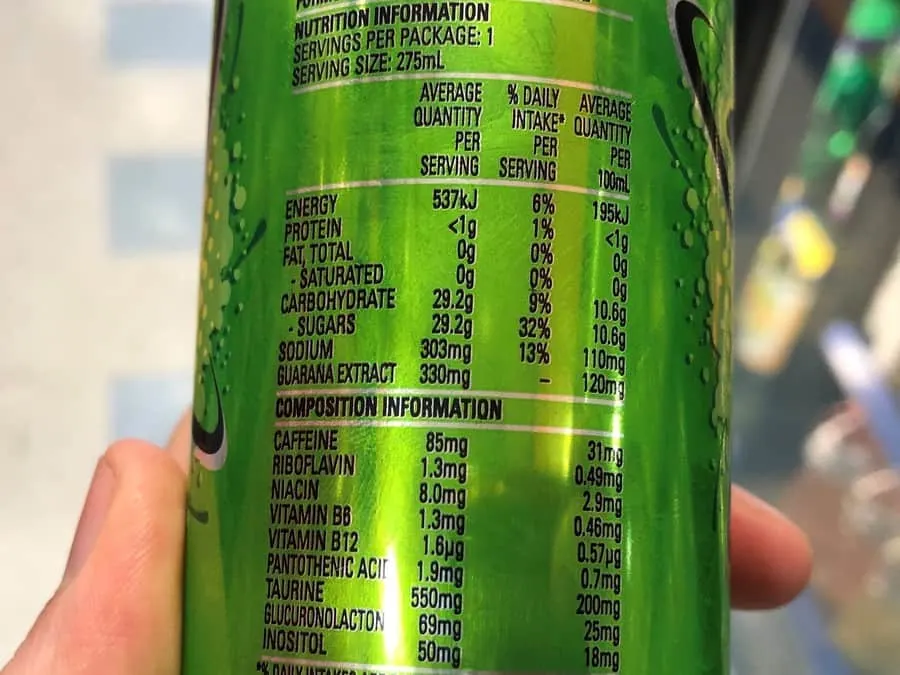
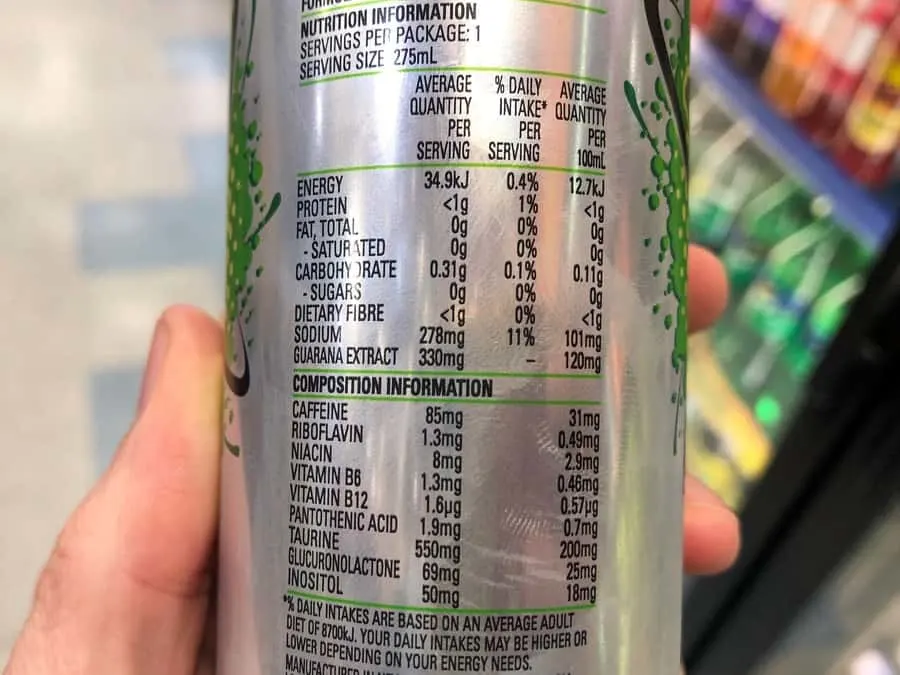
V Energy Drink Calories
At 275ml per can, V Energy Original will net you 128 calories, while V Energy Sugar-Free only has 8 calories in total.
For an energy drink of its size, V Energy has a pretty average amount of calories, considering that a 250ml can of Red Bull already has 110 calories,
Considering you only need about 2000 to 2500 calories per day, a single can of V Energy is enough to give you a boost, but not too much that it might ruin your appetite.
Of course, if you start having multiple cans of V Energy a day, you’re definitely going to add a fair amount of calories into your diet, which may lead to weight gain and other possible side effects.
That being said, having some amount of calories in V Energy isn’t really a bad thing considering your cells do need energy to work, especially if you’re able to burn off all the extra ones through regular exercise.
Avoid substituting energy drinks for meals; they’re great for a quick burst of energy when you need it most, but they can’t replace the nourishment you’d get from an actual meal.
To conclude, having a can of V Energy is great for a small boost but isn’t viable for appeasing your hunger, and drinking more than one can ruin your diet plan if you have one.
If you’re not too fond of calories, V Sugar-Free is a great alternative, with only 8 calories per serving. Alternatively, check out the article I’ve written on the best zero-calorie energy drinks for some other recommendations.
V Energy Drink Ingredients
Here’s a list of all the ingredients in a can of V Energy Drink Original and Sugar-Free, with the most prominent ones highlighted in bold to follow a more in-depth discussion further down below.
V Energy Original (Green)
- Carbonated Water
- Sugar
- Acidity Regulators (Citric Acid, Sodium Citrate)
- Taurine
- Guarana Extract
- Colour (Caramel)
- Glucuronolactone
- Caffeine
- Inositol
- Vitamins (B3, B5, B6, B2, B12)
- Flavours
- Wheat Derivatives
V Energy Sugar-Free
- Carbonated Water
- Acesulfame Potassium
- Sucralose
- Acidity Regulators (Citric Acid, Sodium Citrate)
- Taurine
- Guarana Extract
- Colour (Caramel)
- Glucuronolactone
- Caffeine
- Inositol
- Vitamins (B3, B5, B6, B2, B12)
- Flavours
- Wheat Derivatives
- Xanthan Gum
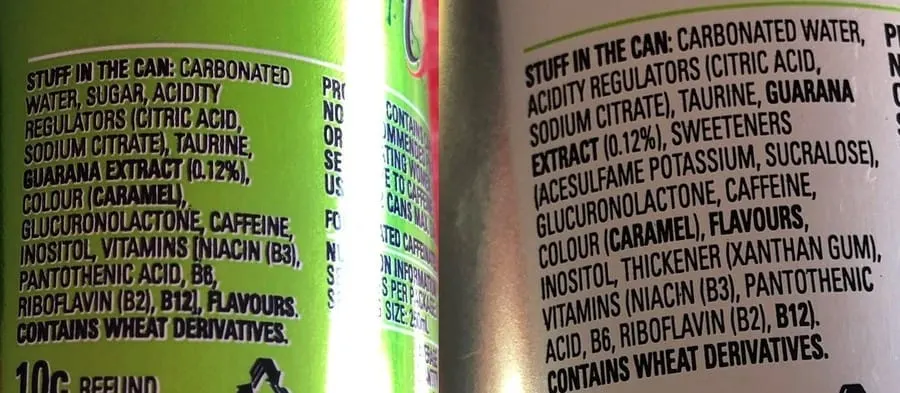
V Energy Drink Ingredients Analysis
Taurine
At 500 mg per 265 ml can of V Energy, taurine is an amino used in plenty of energy drinks, often with a long list of benefits alongside it.
Taurine is a pretty common ingredient within the energy drink circle. You can find it in just about any global brand such as Rockstar and Red Bull, with another notable local taurine user being Mother Energy.
Among the potential benefits you might get from taurine include:
- promoting healthy metabolism
- memory and thinking skills
- improving exercise performance
- protecting the muscles
That said, the science so far hasn’t conclusively proven that there are any immediate or long-term benefits, so it’s best to take these claims with a grain of salt.
Guarana Extract
The most prominently featured ingredient in V Energy Drink is guarana. It is what gives the brand its unique taste and color palette, though guarana extract isn’t unique to only V Energy.
Boasting an impressive mix of stimulants and antioxidants, it’s no surprise why guarana is very much a staple ingredient for energy drinks.
While Guarana is also featured in other energy drinks such as Rockstar, V Energy does seem to turn it up a notch by basing its entire brand around guarana, which definitely makes it stick out from the crowd.
However, a decent percentage of guarana is actually caffeine, so its ability to reduce fatigue and improve focus isn’t all that surprising when given that particular tidbit.
Given that there’s 330 mg of guarana present, and that 3.6% to 5.6% of guarana is made out of caffeine, all the guarana in V Energy will roughly translate to an additional 18.5 mg of caffeine.
However, while the guarana extract may add slightly more caffeine than labeled, V Energy contains a pretty small amount of caffeine, so the additional caffeine from guarana is pretty negligible.
Glucuronolactone
Glucuronolactone is a chemical that is both made in the body and also made synthetically, often finding its way into our food.
Essentially, glucuronolactone is converted into glucuronic acid in the body and is then responsible for the detox and breakdown of glucose molecules, which supposedly increases the energy you gain from sugar more quicker.
That being said, there isn’t enough evidence or studies done on glucuronolactone to determine whether or not its supposed benefits, such as improved exercise performance or cognition, are actually viable.
Given that there’s only 69 mg of glucuronolactone present in V Energy, it’s hard to tell whether there would be any benefits from this particular ingredient, having inefficient scientific evidence and the small dosage.
Inositol
Inositol is a vitamin-like substance that’s created in the body, and being responsible for maintaining the chemical balance in the body along with assisting the function of insulin.
While it supposedly has a positive effect on the nervous system, such as reducing feelings of anxiety, the supposed dosage required for such a benefit is 12 to 18 g.
Given that there are only 50 mg of inositol present in V Energy Original (and absent in V Sugar-Free), it’s hard to say if the amount present has any beneficial properties.
Wheat Derivatives
While it’s not known what wheat derivatives are present in V Energy Drinks, it does mean that V Energy is unfortunately not gluten-free due to the inclusion of this ingredient warning.
Although it’s not a core part of V Energy Drink’s formula, the fact that the drink contains wheat derivative renders it non-gluten-free, which would definitely turn you off from enjoying V if you follow a gluten-free diet.
B Vitamins
V Energy also includes B Vitamins for a slightly healthier drink.
I’ve listed the relevant B-Vitamins in the table below, and for more information on B-Vitamins, click here to read a helpful Harvard resource.
| Purpose | V Energy (275 ml) | Tolerable Upper Intake Level | |
| Vitamin B2 (Riboflavin) | Cell growth and energy production. | 1.3 mg | – |
| Vitamin B3 (Niacin) | Helps the body release energy, and keeps the skin healthy. | 8.0 mg | 35 mg |
| Vitamin B5 | Builds and breaks down fatty acids, and other metabolic functions. | 1.9 mg | – |
| Vitamin B6 | Store energy from protein and carbohydrates, the formation of red blood cells | 1.3 mg | 100 mg |
| Vitamin B12 | Release energy from food, forms red blood cells, keeps the nervous system healthy | 1.6 μg | – |
V Energy Caffeine Content
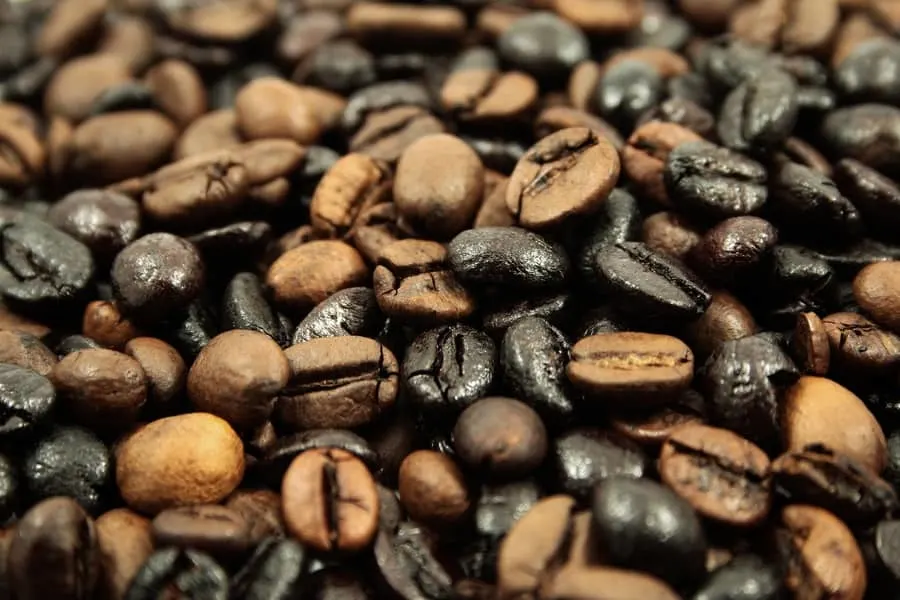
A 275 ml can of V Energy Drink has around 85 mg of caffeine, which is a small amount considering the size.
Caffeine is a pretty important component of energy drinks, as it’s able to keep you awake, temporarily improve reaction times as well as increase cognitive function.
V Energy itself has a fairly small amount of caffeine, having only slightly more than a regular can of Red Bull (80 mg per 250ml) at 85 mg.
Given that there are energy drinks that reach up to 300 mg of caffeine per serving, V Energy is rather mild by comparison, so if you’re not too fond of excessive amounts of caffeine, V Energy is definitely a good option.
Of course, caffeine is only effective if taken within the acceptable limit, so keeping things within your personal tolerable limits and preferences is highly recommended.
Personally, I prefer somewhere between 50 to 100 mg of caffeine per serving for energy drinks.
As such, Green V Energy has just the right amount of caffeine for me, just enough to give me a boost, but not too much that I might feel jittery from all the caffeine later.
But depending on your own caffeine metabolism and how well you tolerate caffeine, you might need a couple more cans before you start to feel the effects kick in, especially if you consume caffeinated beverages regularly.
Still, it’s best not to go too overboard on the caffeine as the FDA approves a max daily caffeine limit of 400 mg, and having any more than that might lead to side effects such as:
- insomnia
- restlessness
- headaches
- dizziness
- dehydration
- anxiety
My advice is to be sure to keep your intake at a reasonable level and do put down the can if you start feeling any of the effects above.
As with any caffeinated beverage, moderation is key. So, have your V Energy drinks wisely, and try not to double down on other caffeinated beverages, such as tea or coffee, if you plan to open a can.
V Energy Sugar Content
A can of V Energy Original will net you 29.2 g of sugar, while V Sugar-Free is, as stated in the name, sugar-free.
According to the AHA, you should keep your daily sugar intake to no more than 25 g for women and 36 g for men, while the UK’s NHS recommends a daily added sugar limit for adults of no more than 30 g for both sexes.
As such, while a can of V Energy Original isn’t quite as excessive as a Monster or Mother Energy Drink (around 50 g per serving for both), it’s still pushing it on how much sugar a day you should have to stay healthy.
Of course, it’s perfectly fine to go on a sugar binge occasionally. It’s a pretty good treat and does give your mood a slight lift due to the dopamine boost you get from it.
It’s only when you start consistently having a diet high in sugar that all the troubles start, as having too much sugar consistently can lead to some notable health problems such as:
- weight gain
- type II diabetes
- increased risk of heart disease
- acne
- increased risk of depression
Having too much sugar in a short period can also lead to you having a sugar crash, and feeling slow and sluggish after a sugar high is probably the last thing you want if you’re trying to get work done.
So if you think the sugar content in V Energy Drink is a bit high, there’s always the sugar-free version of V Energy, albeit with artificial sweeteners instead.
And if you’re looking for other recommendations, check out the article I’ve written on the best energy drinks with less sugar for some notable alternatives.
Does V Energy Drink Use Artificial Sweeteners?
V Sugar-Free does use artificial sweeteners, namely Sucralose and Acesulfame Potassium, instead of sugar, unlike V Original.
As sucralose and acesulfame potassium are zero-calorie sweeteners, you can rest assured knowing that the only thing you’re getting out of them is a sweet taste and none of the extra calories that usually come with it.
That being said, there’s still a bit of uncertainty regarding the long-term use of artificial sweeteners, so it’s still probably best to keep your consumption at minimal levels.
In any case, both sucralose and acesulfame potassium have been approved for general use by the FDA and other health agencies across the world.
So, as long as you’re not consistently having an excessive amount of artificial sweeteners in your food and drink, it should be alright for you to enjoy a can of V Energy occasionally.
Can You Have V Energy Drinks Every Day?
| Green V Energy (275ml) | Sugar-Free V Energy (275ml) | Daily Max Limit (Female/Male) | |
| Calories | 128.35 calories | 8 calories | 2000 calories/2500 calories |
| Sugar | 29.2 g | 0 g | 25 g / 36 g |
| Caffeine | 85 mg | 85 mg | 400 mg |
Based on the nutritional value, it should be perfectly alright for you to have a can of V Energy Drink every day.
Given V Energy’s low caffeine amount, the only thing you have to worry about is the sugar content, given that it’s definitely on the higher end of the spectrum.
That said, the sugar content isn’t really all that excessive, so as long as you know how to moderate your sugar intake and stick to one can a day, you should be fine.
If you don’t want to worry about sugar, V Sugar-Free is probably your best bet, as you only have to worry about the low caffeine content instead of both caffeine and sugar.
Is V Energy Drink Bad For You?
As long as you’re healthy and know how to moderate your caffeine and sugar intake, having a V Energy Drink on occasion is perfectly fine.
Looking through V Energy Drink’s ingredients, there’s really not much present that should be of immediate concern, with an overall nutritional value similar to a slightly sugary cup of iced coffee.
As such, so long as you’re not overdoing it on either the caffeine or sugar in your daily diet, there should be no reason why having a can of V Energy shouldn’t give you a pretty beneficial energy boost to get your work done.
V Energy Drink Alternatives
If you enjoy the taste of V Energy, here are some other alternatives that you might enjoy as well:
REIZE (10 out of 10)
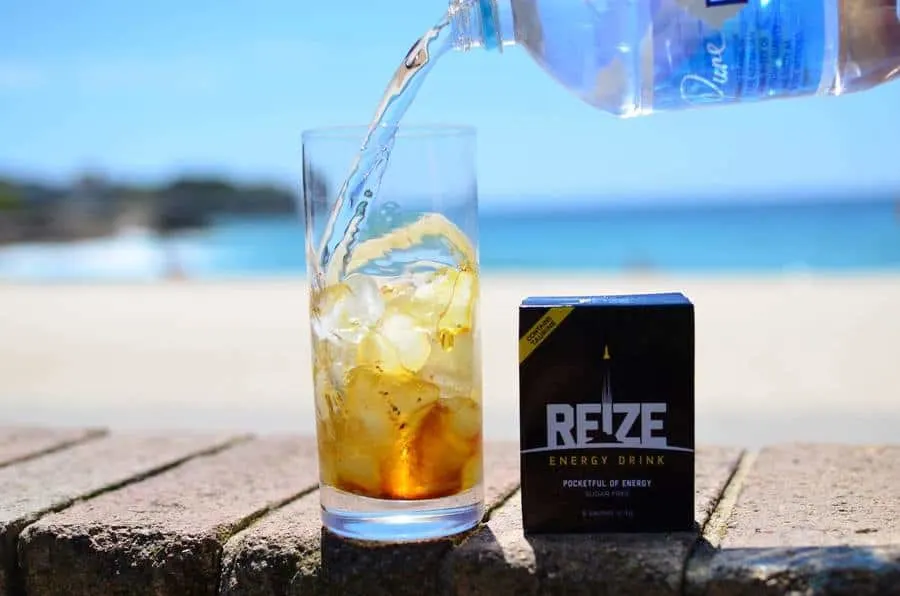
While V Energy might be a pretty good energy drink, if you want something a bit lighter on the caffeine and a lot more affordable, REIZE ticks all the right boxes.
REIZE is a great powdered energy drink that comes in convenient 4 g sachets. With a sensible 50 mg of caffeine, it’s completely sugar-free and has only 11 calories per serving.
REIZE also contains a smart blend of taurine, ginseng, and B-group vitamins, combining to give you the perfect energy boost without the sugar crash afterward.
Best of all, you can get REIZE delivered straight to your door for only about $1 per drink, which is a pretty outstanding value for money.
Try REIZE today, and I’m sure you’ll find it a preferable alternative to V Energy Drinks.

